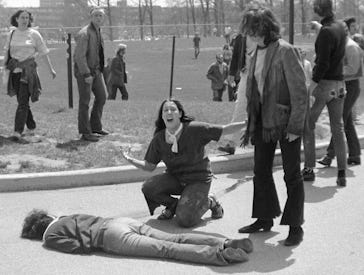Trump went on Truth Social to issue a warning to institutions of higher learning, as well as their students, and in typical Trumpian fashion, he wasn’t exactly subtle…
“Agitators will be imprisoned/or permanently sent back to the country from which they came.”
Remember during the campaign when some students were quoted as saying that there were no difference between the two candidates?
How’s that working out for you?
Combine this with Trump appointments like Hegseth at DOD, Bondi as AG, or Patel at the FBI, and the specter of violence against student protests seems like a very real possibility. Which got me to thinking about the Kent State Massacre, something those students quoted during the campaign have perhaps never heard of, but they should take a moment to learn some history.
On April 30, 1970, amidst already contentious sentiments on the never-ending Vietnam War, then President Richard “Tricky Dick” Nixon, addressed the Nation to announce that he had sent U.S. troops into neutral Cambodia, thereby widening, not winding down, America’s least popular war. A student strike was announced for the next day, and ultimately more than four million students participated in walk-outs.
So it was at the campus of Kent State University in Ohio, and violence on and off campus had occurred in the days since Nixon’s speech. On May 4, some 96 troops of the Ohio National Guard confronted a crowd of student protesters. While some of the protesters threw rocks at the troops, they were otherwise unarmed. The troops ordered the students to disperse, they jeered in response. The troops fired tear gas at the students, but the wind made it mostly ineffective, and some students even threw the canisters back at the troops, to the general delight of the protesters.
The troops advanced on the students who retreated. More tear gas, more taunts. Then, suddenly, without further warning, the troops opened fire at the students, some of whom recalled later that surely, they would be shooting blanks, if they shot at all.
They were not blanks.
In seconds four students lay dead — Allison Krause, 19, Jeffrey Miller, 20, Sandra Lee Scheuer, 20, and William Schroeder, 19 — and nine others were wounded, including one who was permanently paralyzed. The troops who fired on the students were charged with violating their civil rights, but they were acquited in a bench trial.1
"Those who cannot remember the past are condemned to repeat it" — George Santayana.
In community, forward!
Notes:
Kent State Massacre — Wikipedia
Kent State photo by John Paul Filo, who was a journalism student at Kent State University at the time - © 1970 Valley News-Dispatch, immediate source, Fair use.
Ohio, by Neil Young, performed by Crosby, Stills, Nash & Young.
In what must have been cold comfort for the loved ones of the slain students, the trial judge wrote: “It is vital that state and National Guard officials not regard this decision as authorizing or approving the use of force against demonstrators, whatever the occasion of the issue involved. Such use of force is, and was, deplorable.“






I knew my Constitutional right to peaceful protest. I was an idealistic college junior that day in May, 1970, when Kent State students protested the Vietnam war. Like them, every evening I heard the nightly newscaster intone the roll call of the dead. Like them, I prayed that we would put an end to the fighting and the unrelenting summoning of our friends by the draft board. Even today, reflecting on that time, my hands shake over the keys of my computer as I remember how shock turned to horror and disbelief at the announcement of their deaths. "How many deaths will it take till we know that too many people have died? The answer, my friend, is blowing in the wind. The answer is blowing in the wind." Bob Dylan